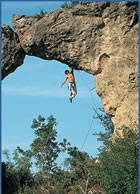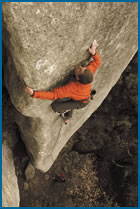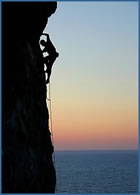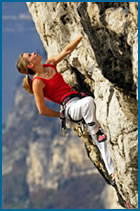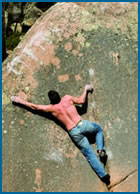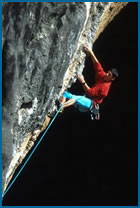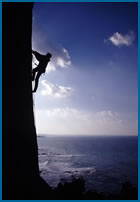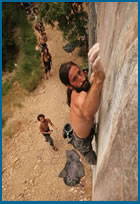Rock climbing in Europe
Climb Europe is all about describing the best rock climbing areas within Europe, to help climber's plan their rock climbing holidays, book accommodation and buy rock climbing guidebooks from our shop.
Rock Climbing in Albania. Tirana is the best place to go rock climbing in Albania, with the 3 largest crags being Bovilla, Brar and Krraba.
Rock climbing in Austria. Austria is situated in the heart of the Alps and as such is a very mountainous country with many peaks over 3,000m. The range of climbing available is huge, from bouldering, single pitch sport climbing to multi-pitch climbing (trad and bolted) many 100’s metres long.
Rock climbing in Belgium. Freyr is the most well known Belgium crag. However there are many more limestone crags offering excellent sport climbing.
Rock Climbing in Bosnia and Herzegovina is an underrated climbing destination where it is possible to get off the beaten track, experience a different culture, and climb on routes that aren’t polished and avoid the crowds. Popular crags include Pecka, Tijesno Canyon, Dreznica, and Blagaj.
Map of European Rock Climbing Areas
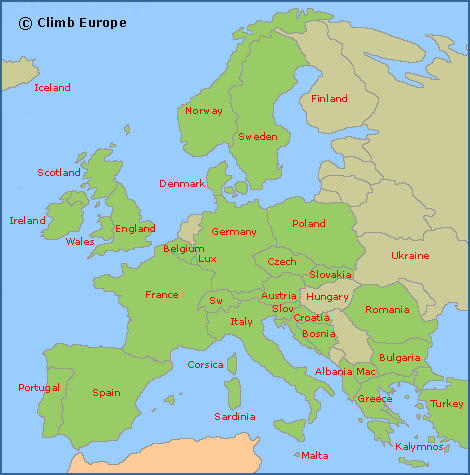
Rock Climbing in Bulgaria. This small country is an excellent place for an activity holiday with many places to go rock climbing. Vratsa is the largest rock climbing area, where there are many big walls and isolated towers, including the longest wall in Bulgaria, the Central Wall, which is 350m long.
Rock Climbing in Corsica. There is an abundance of beautiful bolted rock to climb in Corsica, from coarse weathered granite rock, to sandstone or limestone rock. At the Gorges de la Restonica there are 100's of sports routes on bolted granite rock.
Rock climbing in Croatia. The centrepiece of Croatian climbing is Paklenica National Park, with its 300m face of Anica kuk giving fantastic big wall climbing. There are plenty of sports climbing areas in the country; especially in the north near Pula, Rovinj, Porec and Pazin; and around Split, Omis and the islands of Hvar and Brac.
Rock Climbing in Cyprus. There are currently 5 main sport climbing areas in Cyprus with the largest areas being around Paphos and the Pentadaktylos mountains in Northern Cyprus. In total there are over 600 routes spread across 25 different crags, with routes for everyone from the low F5’s to around F8b+/8c.
Rock climbing in Czech Republic. Czech climbing is not all about scary sandstone routes protected by knotted slings. Some of these sandstone crags have well protected sport routes as well the adventurous trad routes. There is also some excellent granite bouldering and limestone sport crags to explore.
Rock climbing in Denmark. Denmark’s best rock climbing area is the delightful holiday island of Bornholm that offers friendly climbing, which along with a pleasant climate, interesting history and hospitable inhabitants, makes Bornholm a great rock climbing holiday destination.
Rock climbing in England. In England there are many different types and styles of climbing available, from Deep Water Soloing (DWS), bouldering, single pitch traditionally protected routes, bolted sport routes to long multi-pitch traditional routes in the mountains. The rock climbing in England is very varied due to the different types of rock to found and climbed on, such as gritstone, limestone, granite, sandstone and the mountain rock of the Lake District.
Rock climbing in France. As well as the famous sandstone bouldering at Fontainebleau, and Alpine rock climbing at Chamonix, there are many other excellent rock climbing and sport climbing areas. These include Verdon, the Hautes Alps and many sports crags around Avignon in the south to Dijon in the centre of France.
Rock climbing in Germany. Frankenjura is the jewel of Germany’s many rock climbing areas, with its short powerful single pitch sport routes. There are many other climbing areas in Germany, particularly in the south of the country at places such as Allgäu and Blautal.
Rock climbing in Greece. The most famous rock climbing area within Greece is found at Kalymnos. This small island near Kos is an excellent sport climbing destination with great weather throughout the year and many superb bolted limestone routes at every grade.
However, there are many other rock climbing areas within Greece such as Meteora, Patra and on the islands of Crete and Rhodes.
Rock climbing in Ireland. Ireland has a great history of traditional rock climbing on sea cliffs and in the mountains that are often in wild and beautiful places. Some of the main rock climbing areas in Ireland are at Ailladie, Fair Head, the Mournes Mountains, Glendalough and Dalkey Quarry.
Rock climbing in Italy is dominated by the Dolomites, with its big wall rock climbing. The limestone big walls are as tall as 800m with an abundance of classic routes, many of which can be reached with fairly short walks from the road. Other excellent rock climbing areas include Arco, near Lake Garda and Finale Ligure on the Mediterranean coast near France.
Rock climbing in Luxembourg. The best place to go rock climbing in Luxembourg is at Berdorf, which is situated near the border with Germany, about 5km from the town of Echternach, and around 20km from Luxembourg-Ville. The climbing is on the sandstone crag of Wanterbaach just outside the village of Berdorf. The situation is very beautiful with the crag set within a forest.
Rock climbing in Macedonia. The bouldering area of Prilep is the best place to go climbing in Macedonia. There are also a number of other rock climbing and sport climbing areas situated in gorges, mountains or beside lakes.
Rock climbing in Romania. There are many of excellent rock climbing areas in Romania and there is scope for adding plenty of new routes and/or opening up new areas. The popular rock climbing areas are Baile Herculane, Ceile Bicazului, the Bucegi mountains and the Trascau mountains, which includes the Turda gorge.
Rock climbing in Sardinia has always been popular especially the limestone sport climbing around Cala Gonone. Discover other climbing areas in Sardinia, including traditional multi-pitch climbing and sport climbing at places such as Isili and Domusnovas. They are many bouldering areas on the island usually on fantastic granite rock.
Rock climbing in Scotland. There is a great variety of rock climbing to be found in Scotland, which ranges from huge mountain crags, remote sea cliff climbing to smaller outcrops, sport climbing venues and bouldering.
Rock climbing in Serbia. Serbia is a country with a diverse mountainous karst landscape of deep gorges, remote valleys, and huge caves. Scattered across Serbia are many excellent limestone crags offering solitude and adventure when compared to other European countries. Some of the larger crags include Niševačka klisura, Jelašnička Klisura, Kanjon Resave, and Grdoba.
Rock climbing in Slovakia. Slovakia has a rich history of rock climbing and mountaineering. The Tetras Mountains in the north of the country offer Alpine and multi-pitch climbing, whilst the rest of the country there are many sport climbing areas.
Rock climbing in Slovenia. Slovenia is fast becoming a popular holiday destination, and it also offers superb rock climbing. There are over 70 sports crags within Slovenia, all of which are sensibly bolted and on solid rock - more than enough for several weeks of excellent rock climbing.
Rock climbing in Spain. It is easy to understand why Spain has become the premier winter sun rock destination, with ideal conditions from autumn through to spring. As well as rock climbing in Costa Blanca area there are numerous other areas such as; the southern region of Andalucia that includes El Chorro, around Malaga and Granada; the island of Mallorca; bouldering at Albarracin; and many rock climbing areas around Barcelona and Catalunya that are well worth a visit.
Rock climbing in Sweden. The climbing in Sweden is all about cragging on single pitch trad and sport routes, plus excellent bouldering usually on good quality granite rock. Not only is the climbing excellent but it is situated in stunning locations such as, next to the sea, in hillside meadows or in forests.
Rock climbing in Switzerland. Switzerland is situated in the heart of the Alps and as such is a very mountainous country with many peaks over 4,000m. As well as the high level mountaineering there are many pure rock climbing areas within Switzerland across a variety of rock including granite, limestone and gneiss. The range of climbing available is huge, from bouldering, single pitch sport climbing to multi-pitch climbing (trad and bolted) many 100’s metres long.
Rock climbing in Turkey. If you are after a cheap rock climbing holiday, look no further than Geyikbayiri near Antalya. Turkey also offers almost limitless potential for developing new routes and whole rock climbing areas.
Rock climbing in Wales. Wales offers a wide variety of rock climbing from long multi-pitch routes and bouldering in the mountains of Snowdonia; sport climbing in old quarries, to sea cliff climbing in Gogarth and Pembroke.
